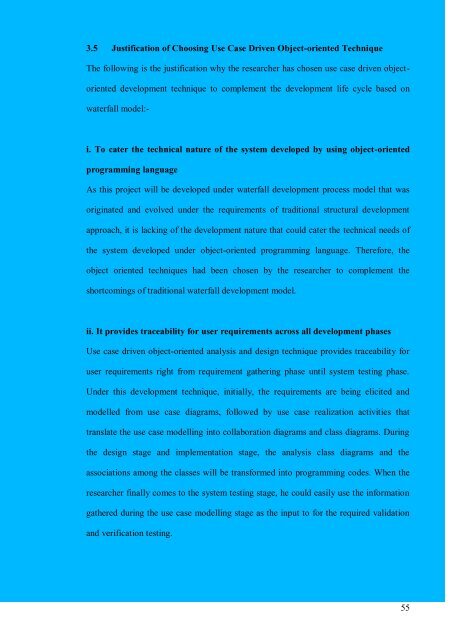Table of Contents - DSpace@UM
Table of Contents - DSpace@UM
Table of Contents - DSpace@UM
You also want an ePaper? Increase the reach of your titles
YUMPU automatically turns print PDFs into web optimized ePapers that Google loves.
3.5 Justification <strong>of</strong> Choosing Use Case Driven Object-oriented Technique<br />
The following is the justification why the researcher has chosen use case driven objectoriented<br />
development technique to complement the development life cycle based on<br />
waterfall model:-<br />
i. To cater the technical nature <strong>of</strong> the system developed by using object-oriented<br />
programming language<br />
As this project will be developed under waterfall development process model that was<br />
originated and evolved under the requirements <strong>of</strong> traditional structural development<br />
approach, it is lacking <strong>of</strong> the development nature that could cater the technical needs <strong>of</strong><br />
the system developed under object-oriented programming language. Therefore, the<br />
object oriented techniques had been chosen by the researcher to complement the<br />
shortcomings <strong>of</strong> traditional waterfall development model.<br />
ii. It provides traceability for user requirements across all development phases<br />
Use case driven object-oriented analysis and design technique provides traceability for<br />
user requirements right from requirement gathering phase until system testing phase.<br />
Under this development technique, initially, the requirements are being elicited and<br />
modelled from use case diagrams, followed by use case realization activities that<br />
translate the use case modelling into collaboration diagrams and class diagrams. During<br />
the design stage and implementation stage, the analysis class diagrams and the<br />
associations among the classes will be transformed into programming codes. When the<br />
researcher finally comes to the system testing stage, he could easily use the information<br />
gathered during the use case modelling stage as the input to for the required validation<br />
and verification testing.<br />
55

















